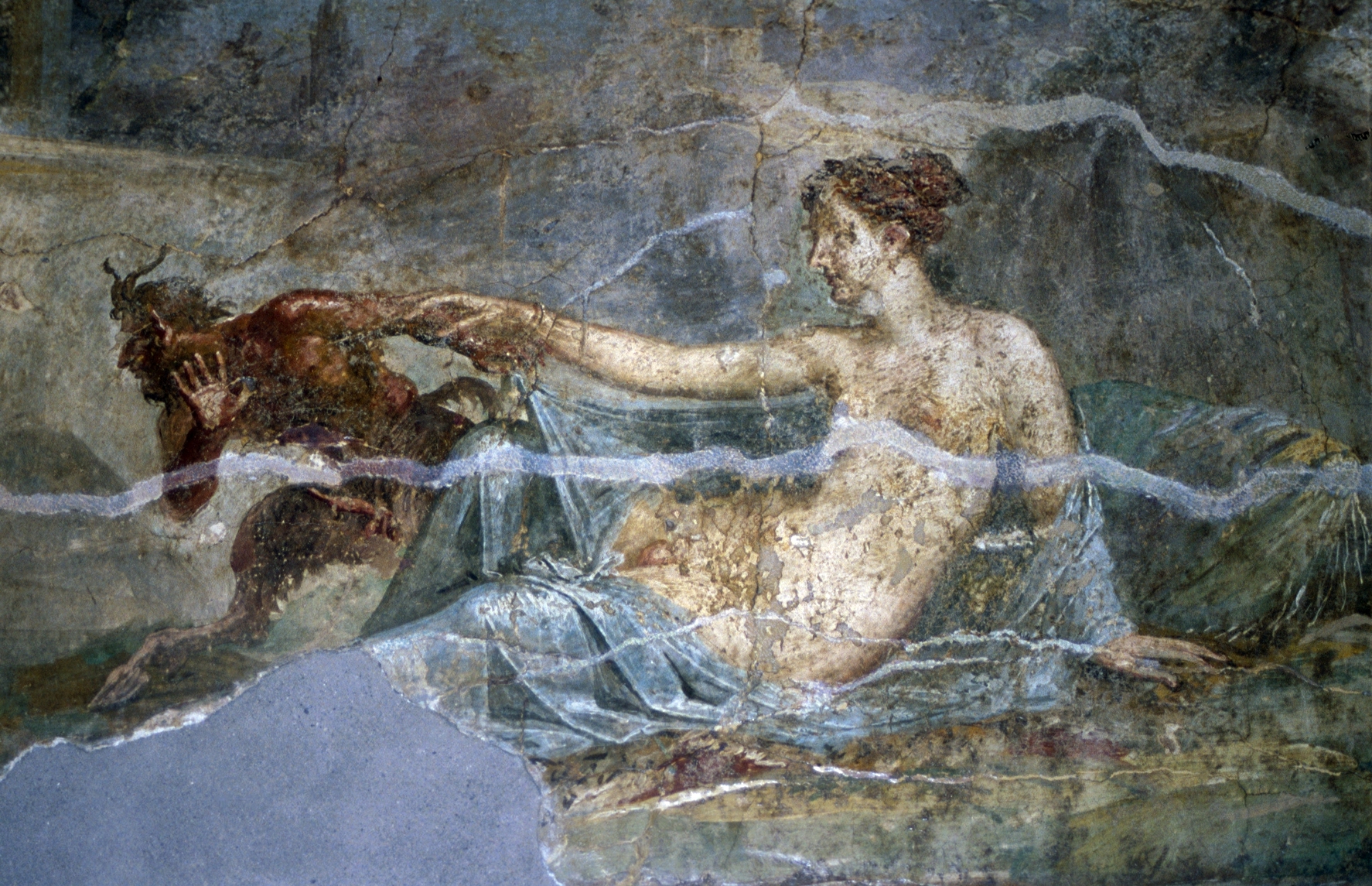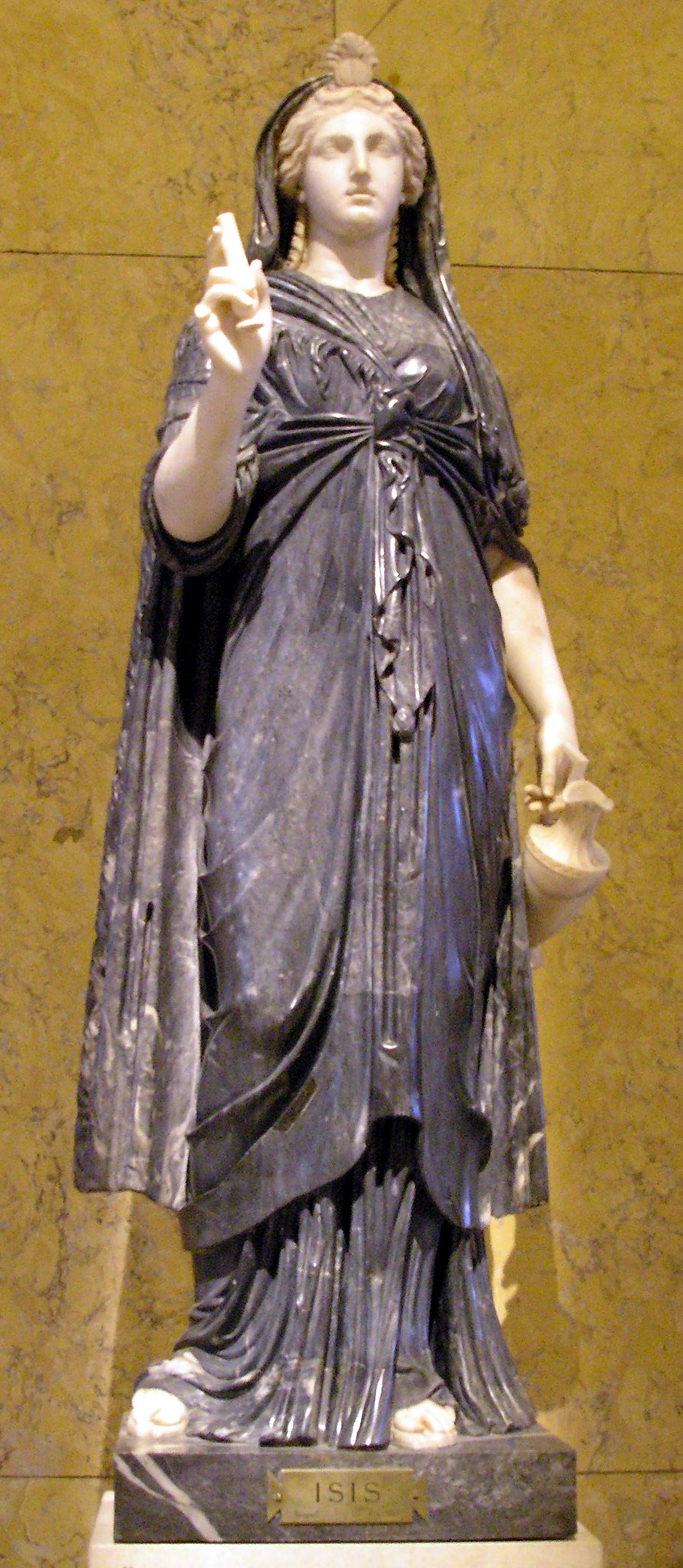|
Lupercus (mythology)
Lupercus or Lubercus or Luberkus was a god in Roman mythology. Lupercus was a protector of the farmers, harvesting and packs of wild animals. Every year on 15 February in honor of him, the Romans held the Lupercalia. He was an ancient Italian god, worshipped by shepherds as the promoter of fertility in sheep and protector of flocks. He helped the she-wolf take care of Romulus and Remus; this is why Lupercalia was a celebration that helped pregnant women. Lupercus is sometimes identified with the god Pan in Greek mythology A major branch of classical mythology, Greek mythology is the body of myths originally told by the Ancient Greece, ancient Greeks, and a genre of Ancient Greek folklore. These stories concern the Cosmogony, origin and Cosmology#Metaphysical co .... The Roman god Faunus is a variation of Lupercus, also linked to the festival of Lupercalia. References Roman gods Lupercalia Agricultural gods Nature gods {{AncientRome-myth-stub ... [...More Info...] [...Related Items...] OR: [Wikipedia] [Google] [Baidu] |
Roman Mythology
Roman mythology is the body of myths of ancient Rome as represented in the literature and visual arts of the Romans. One of a wide variety of genres of Roman folklore, ''Roman mythology'' may also refer to the modern study of these representations, and to the subject matter as represented in the literature and art of other cultures in any period. Roman mythology draws from the mythology of the Italic peoples and ultimately from Proto-Indo-European mythology. Roman mythology also draws directly on Greek mythology, potentially as early as Rome's protohistory, but primarily during the Hellenistic period of Greek influence and through the Roman conquest of Greece, via the artistic imitation of Greek literary models by Roman authors. The Romans identified their own gods with those of the ancient Greeks—who were closely historically related in some cases, such as Zeus and Jupiter—and reinterpreted myths about Greek deities under the names of their Roman counterparts. Greek and ... [...More Info...] [...Related Items...] OR: [Wikipedia] [Google] [Baidu] |
Harvest
Harvesting is the process of gathering a ripe crop from the fields. Reaping is the cutting of grain or pulse for harvest, typically using a scythe, sickle, or reaper. On smaller farms with minimal mechanization, harvesting is the most labor-intensive activity of the growing season. On large mechanized farms, harvesting uses the most expensive and sophisticated farm machinery, such as the combine harvester. Process automation has increased the efficiency of both the seeding and harvesting processes. Specialized harvesting equipment utilizing conveyor belts to mimic gentle gripping and mass-transport replaces the manual task of removing each seedling by hand. The term "harvesting" in general usage may include immediate postharvest handling, including cleaning, sorting, packing, and cooling. The completion of harvesting marks the end of the growing season, or the growing cycle for a particular crop, and the social importance of this event makes it the focus of seasonal celebrati ... [...More Info...] [...Related Items...] OR: [Wikipedia] [Google] [Baidu] |
Wild Animals
Wildlife refers to undomesticated animal species, but has come to include all organisms that grow or live wild in an area without being introduced by humans. Wildlife was also synonymous to game: those birds and mammals that were hunted for sport. Wildlife can be found in all ecosystems. Deserts, plains, grasslands, woodlands, forests, and other areas, including the most developed urban areas, all have distinct forms of wildlife. While the term in popular culture usually refers to animals that are untouched by human factors, most scientists agree that much wildlife is affected by human activities. Some wildlife threaten human safety, health, property, and quality of life. However, many wild animals, even the dangerous ones, have value to human beings. This value might be economic, educational, or emotional in nature. Humans have historically tended to separate civilization from wildlife in a number of ways, including the legal, social, and moral senses. Some animals, howev ... [...More Info...] [...Related Items...] OR: [Wikipedia] [Google] [Baidu] |
Lupercalia
Lupercalia was a pastoral festival of Ancient Rome observed annually on February 15 to purify the city, promoting health and fertility. Lupercalia was also known as ''dies Februatus'', after the purification instruments called ''februa'', the basis for the month named '' Februarius''. Name The festival was originally known as Februa ("Purifications" or "Purgings") after the ' which was used on the day.. It was also known as ' and gave its name variously, as epithet to Juno Februalis, Februlis, or Februata in her role as patron deity of that month; to a supposed purification deity called Februus; and to February ('), the month during which the festival occurred. Ovid connects ' to an Etruscan word for "purging". The name ''Lupercalia'' was believed in antiquity to evince some connection with the Ancient Greek festival of the Arcadian Lykaia, a wolf festival ( grc-gre, λύκος, ''lýkos''; la, lupus), and the worship of ''Lycaean Pan'', assumed to be a Greek equivalent to ... [...More Info...] [...Related Items...] OR: [Wikipedia] [Google] [Baidu] |
She-wolf (Roman Mythology)
In the Roman foundation myth, it was a she-wolf (lupa) that nursed and sheltered the twins Romulus and Remus after they were abandoned in the wild by order of King Amulius of Alba Longa. She cared for the infants at her den, a cave known as the Lupercal, until they were discovered by a shepherd, Faustulus. Romulus would later become the founder and first king of Rome. The image of the she-wolf suckling the twins has been a symbol of Rome since ancient times and is one of the most recognizable icons of ancient mythology. Origins There is evidence that the wolf held a special place in the world of the ancient peoples of Italy. One legend claims that the Hirpini people were so-called because, when they set out to find their first colony, they were led to its location by a wolf (from the Osco-Umbrian word for wolf: ''hirpus''). The tale of the Lupercal is central to that of the twins, and probably predates theirs. To the Roman god Mars, the wolf is a sacred animal. There is an ... [...More Info...] [...Related Items...] OR: [Wikipedia] [Google] [Baidu] |
Romulus And Remus
In Roman mythology, Romulus and Remus (, ) are twin brothers whose story tells of the events that led to the founding of the city of Rome and the Roman Kingdom by Romulus, following his fratricide of Remus. The image of a she-wolf suckling the twins in their infancy has been a symbol of the city of Rome and the ancient Romans since at least the 3rd century BC. Although the tale takes place before the founding of Rome around 750 BC, the earliest known written account of the myth is from the late 3rd century BC. Possible historical bases for the story, and interpretations of its various local variants, are subjects of ongoing debate. Overview Romulus and Remus were born in Alba Longa, one of the many ancient Latin cities near the future site of Rome. Their mother, Rhea Silvia, was a vestal virgin and the daughter of the former king, Numitor, who had been displaced by his brother Amulius. In some sources, Rhea Silvia conceived them when their father, the god Mars, visited her ... [...More Info...] [...Related Items...] OR: [Wikipedia] [Google] [Baidu] |
Pan (god)
In ancient Greek religion and Greek mythology, mythology, Pan (; grc, wikt:Πάν, Πάν, Pán) is the god of the wild, shepherds and flocks, Pastoral#Pastoral music, rustic music and impromptus, and companion of the nymphs. He has the hindquarters, legs, and horns of a goat, in the same manner as a faun or satyr. With his homeland in rustic Arcadia (ancient region), Arcadia, he is also recognized as the god of fields, groves, wooded glens, and often affiliated with sex; because of this, Pan is connected to fertility and the season of spring. In Religion in ancient Rome, Roman religion and myth, Pan's counterpart was Faunus, a nature god who was the father of Bona Dea, sometimes identified as Fauna (goddess), Fauna; he was also closely associated with Silvanus (mythology), Sylvanus, due to their similar relationships with woodlands. In the 18th and 19th centuries, Pan became a significant figure in Romanticism, the Romantic movement of western Europe and also in the 20th-centu ... [...More Info...] [...Related Items...] OR: [Wikipedia] [Google] [Baidu] |
Greek Mythology
A major branch of classical mythology, Greek mythology is the body of myths originally told by the Ancient Greece, ancient Greeks, and a genre of Ancient Greek folklore. These stories concern the Cosmogony, origin and Cosmology#Metaphysical cosmology, nature of the world, the lives and activities of List of Greek mythological figures, deities, Greek hero cult, heroes, and List of Greek mythological creatures, mythological creatures, and the origins and significance of the ancient Greeks' own cult (religious practice), cult and ritual practices. Modern scholars study the myths to shed light on the religious and political institutions of ancient Greece, and to better understand the nature of myth-making itself. The Greek myths were initially propagated in an oral tradition, oral-poetic tradition most likely by Minoan civilization, Minoan and Mycenaean Greece, Mycenaean singers starting in the 18th century BC; eventually the myths of the heroes of the Trojan War and its after ... [...More Info...] [...Related Items...] OR: [Wikipedia] [Google] [Baidu] |
Roman Gods
The Roman deities most widely known today are those the Romans identified with Greek counterparts (see ''interpretatio graeca''), integrating Greek myths, iconography, and sometimes religious practices into Roman culture, including Latin literature, Roman art, and religious life as it was experienced throughout the Empire. Many of the Romans' own gods remain obscure, known only by name and sometimes function, through inscriptions and texts that are often fragmentary. This is particularly true of those gods belonging to the archaic religion of the Romans dating back to the era of kings, the so-called "religion of Numa", which was perpetuated or revived over the centuries. Some archaic deities have Italic or Etruscan counterparts, as identified both by ancient sources and by modern scholars. Throughout the Empire, the deities of peoples in the provinces were given new theological interpretations in light of functions or attributes they shared with Roman deities. An extensive al ... [...More Info...] [...Related Items...] OR: [Wikipedia] [Google] [Baidu] |
Agricultural Gods
Agriculture or farming is the practice of cultivating plants and livestock. Agriculture was the key development in the rise of sedentary human civilization, whereby farming of domesticated species created food surpluses that enabled people to live in cities. The history of agriculture began thousands of years ago. After gathering wild grains beginning at least 105,000 years ago, nascent farmers began to plant them around 11,500 years ago. Sheep, goats, pigs and cattle were domesticated over 10,000 years ago. Plants were independently cultivated in at least 11 regions of the world. Industrial agriculture based on large-scale monoculture in the twentieth century came to dominate agricultural output, though about 2 billion people still depended on subsistence agriculture. The major agricultural products can be broadly grouped into foods, fibers, fuels, and raw materials (such as rubber). Food classes include cereals (grains), vegetables, fruits, cooking oils, meat, milk, egg ... [...More Info...] [...Related Items...] OR: [Wikipedia] [Google] [Baidu] |

.jpg)






